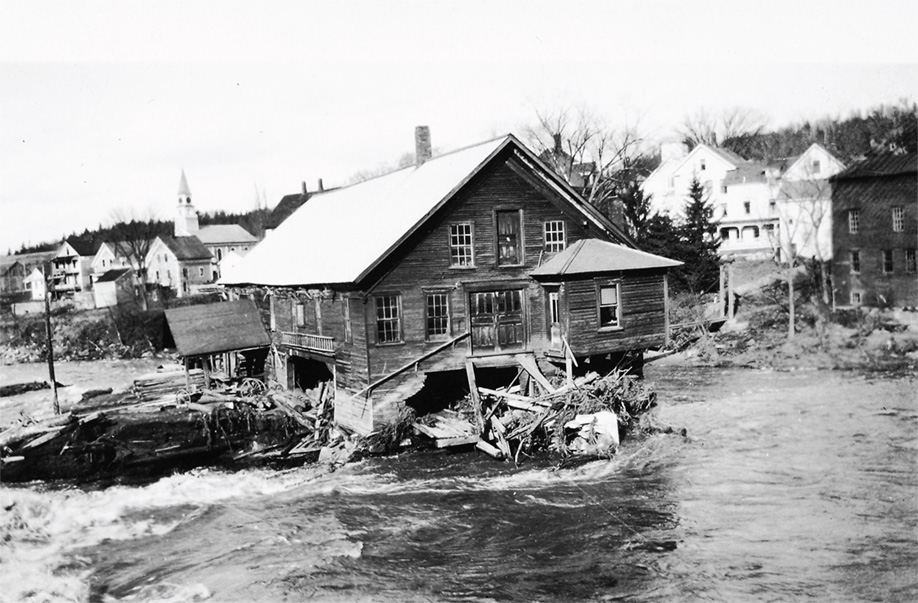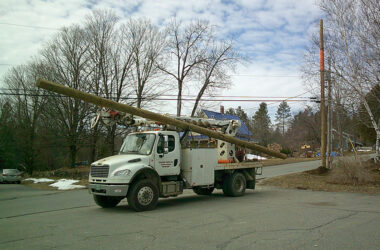
photo courtesy Hardwick Historical Society
This sawmill was located across the river from the Town House.
[The following is an excerpt from the Summer 2023 edition of The Hardwick Historical Society Journal, reprinted with permission to provide historical perspective on recent events.]
by Elizabeth Dow, Tom Dunn, Lorraine Hussey and Tyler Molleur, Hardwick Historical Society
VERMONT – Almost a century later people still remember the 1927 flood, because it made such an impact on the people around them who lived through it. Not only has it been called the worst natural disaster to hit the state, it has received more scrutiny than any other.

photo courtesy Hardwick Historical Society
The Mackville gulch that resulted from the 1927 flooding in Hardwick.
The rain began at 10 p.m., November 2, and continued until 11 a.m., November 4. The heaviest rain came during the afternoon and evening of November 3 when more than seven inches fell in a six-hour period. The state had experienced unusually heavy precipitation in late summer and fall and the soil could not absorb the rain, sending it into already fairly full streams.
The flood reached its height during the evening of November 3. Brooks overflowed and rivers became torrents, reaching a height of thirteen feet or more above their normal depths. They swept dams, bridges, and embankments out of their way or ahead of them. Villages located along the rushing streams were engulfed, factories submerged, farm animals drowned, and homes and barns destroyed. The flood left behind a trail of eroded farm land, layers of silt, gravel, and debris, and disorganized towns.

photo courtesy Hardwick Historical Society
During the 1927 flooding in Hardwick the water lifted this house on Carey Road off its foundation and spun it halfway around before setting it down.
The flood killed eighty-four people and countless animals, domestic and wild. The state estimated it destroyed or severely damaged a total of 1,258 bridges and that the total damage to the state’s highways and bridges amounted to $7,755,000 (approximately $131 million in 2023). Total flood damage in the state was estimated at $35 million (approximately $590 million in 2023.)
After the flood, President Calvin Coolidge, himself a Vermonter, spread the myth of the “indomitable spirit” of Vermonters who found strength within themselves and sought help from no one in meeting the adversity. However, historical research has shown that the enormity of the task of rebuilding town roads and bridges necessarily caused state government, financed by a combination of state and federal revenues, to lead the recovery effort. As a result, those state-directed recovery efforts produced at least two effects of long-term importance: the emphasis on state control of recovery activities and the de-emphasis of traditional local autonomy contributed importantly to the growth of the state bureaucracy; and the reconstruction of Vermont’s highway system with hard-surfaced roads greatly accelerated the arrival of the age of the motor vehicle in Vermont, making the events of 1927 a prelude to the larger economic, social, and cultural changes of the 1930s and beyond.

photo courtesy Hardwick Historical Society
These houses were along Mill Street. The sawmill is to the left and Glenside Avenue climbs the hill in the background. It snowed shortly after the November flood.
(All the information and some of the language in this piece comes from Woodsmoke Productions and Vermont Historical Society, “The Flood of ‘27, 1927,” The Green Mountain Chronicles radio broadcast and background information, original broadcast 1988-89. https://vermonthistory.org/flood-of-27-1927. (accessed July 12, 2023). For much more on the statewide impact of the ’27 flood, go to that URL.Equal Housing.)
HARDWICK – The flood of November 3 to November 4, 1927, stands as the greatest natural disaster in Vermont history. Devastation occurred throughout the state, with 1285 bridges lost, as well as countless homes and buildings, along with hundreds of miles of roads and railroad tracks washed out. The flood water claimed 84 lives, including Vermont Lieutenant Governor, Hollister Jackson.

photo courtesy Hardwick Historical Society
Part of the 200,000 board feet of lumber the sawmill lost was washed away by the flood.
Rainfall during October had averaged 150% of normal across the state. In some northern and central weather stations, that figure rose to 200% to 300%. Heavy rainfalls during the month occurred far enough apart that they caused no flooding. It did saturate the soil, however. Further, by November, most vegetation had died, so it didn’t absorb any of the rain which ran, instead, downhill to the closest stream or river.
On the third day of November, a vast cloud swept down from Canada across the east end of Lake Ontario. At about the same time, a tropical storm came howling up the Atlantic seaboard and swung west across New England. Over Vermont, the warm Caribbean air met the cold Canadian cloud bank. For 39 hours, neither budged. Meteorologists call it a freak of nature and estimate in those 39 hours, a cubic mile of water fell on Vermont.
In East Hardwick, the Kittredge woodworking shop, owned and operated by Wallace Thomas as a sawmill, was surrounded and undermined; it fell into the river, as did A. R. Montgomery’s storehouse. The main water pipe across the river broke, leaving the west side of the village without water, and large landslides, repeated the following Sunday, together with the wrecked bridge a mile below the village, blocked the railroad so effectively that, for a few weeks, no rail traffic could get past East Hardwick.

photo courtesy Hardwick Historical Society
A gulch divided Mackville.
Mackville Pond, one of three storage dams built by the Woodbury Granite Company, began to overflow shortly after 5 p.m. running down a section of the main road and then diverting down another road leading to Edward Carey’s building (now known as Carey Road). The water took the Carey house off its foundation.
In the end, 1,000 feet of Mackville Road had washed out to a depth of 40 to 50 feet in places. The fill used in repairing it included junk iron, old cars, and farm equipment.
The dam held at Jackson Bridge, but the bridge itself washed away.
Houses on the south side of Mill Street washed away, but both the Main Street Bridge and the Daniels footbridge [the Swinging Bridge], built high above the water, survived.
The power plant built by the Woodbury Granite Company in Woodbury Gulf, near the artesian well, washed away.
The mill Orin Hall owned during the 1869 flood was owned by Roy and Fulford Roy. The flood sent the contents of the mill yard, 200,000 board feet of sawed lumber, down the river.
Wolcott Street, washed out to within 10 feet of the Lawson block [the old Flood Zone].
Mail delivery became a major issue, because almost no other means of communication existed.
Flooding continues throughout the state, but no event has approached the Flood of 1927 for real extent: the 1927 event was a rarity, with a return period of hundreds of years.
[In November, 2007, Tom Dunn and Lorraine Hussey made a
presentation about the Flood of ’27 in Hardwick. Tyler Molleur,
then an eighth grader at Craftsbury Academy, researched the weather
component. The Hardwick Historical Society Journal goes to the mailbox of every member quarterly. To join, go to hardwickvthistory.org]







